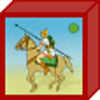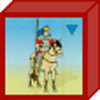Historical Background
Spartacus found his army trapped between the armies of Marcus Licinius Crassus to his front and Gnaeus Pompey, approaching from the rear. Crassus had started construction of his camp when a skirmish between the two armies escalated into a full battle. Crassus’s troops formed more quickly, and launched an effective attack before Spartacus could deploy all of his troops. Spartacus, seeing that his army was in jeopardy, killed his warhorse in front of the troops he had formed, a clear sign of defiance that could only mean one thing—he would fight to the death. As it became clear that his army was being defeated, Spartacus attempted to cut his way through the Roman troops to kill Crassus in one last desperate attempt to save the day. Spartacus was cut down by an arrow. In the end, thousands of men lay dead near the River Silarus, with Spartacus simply one body amongst many. Over 6,000 slave soldiers were captured, and Crassus had them all crucified along the Appian Way, from Capua to Rome. Crassus had defeated Spartacus, but Pompey managed to mop up a few thousand slave fugitives, and took credit for ending the rebellion.
The stage is set. The battle lines are drawn and you are in command. The rest is history.

 |  |  |  |  |  | ||||||||||||||
| 4 | 4 | 3 | 4 | 3 | 3 | ||||||||||||||
 |  |  |  |  |  | ||||||||||||||
| 4 | 2 | 9 | 3 | 2 | 3 |
War Council
Roman Army
• Leader: Crassus
• 6 Command Cards ![]()
![]()
![]()
![]()
![]()
![]()
Victory
6 Banners
Special Rules
• A Slave unit that captures (occupies) the camp hex counts as a Victory Banner for the Slave player. As long as the Slave unit remains on the hex it counts toward the Slave victory. If it moves off or is eliminated, it no longer counts.
• Because Pompey’s army is advancing on the army of Spartacus from the rear, any Slave unit that is forced to retreat from the last row of the battlefield (where it would normally lose one block per retreat hex) will simply lose the entire unit, not just one block per each remaining retreat hex. This rule applies if the unit occupies a last row hex and is forced to retreat, or if it retreats into a last row hex with additional retreat hexes remaining. Eliminate the unit immediately and award the Roman player a Victory Banner.
• Marius Legions Rule is in effect.
• ‘I Am Spartacus’ Slave player rule is in effect.
